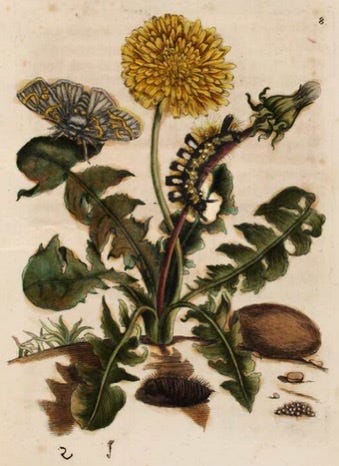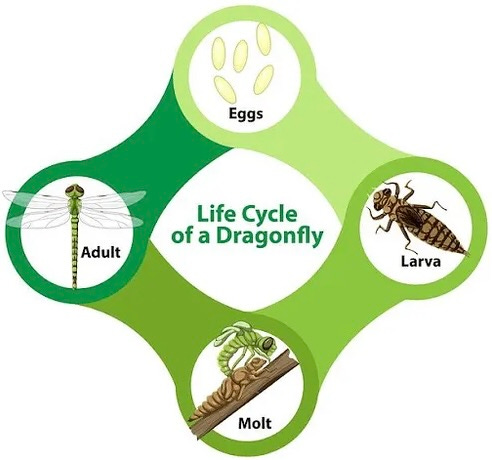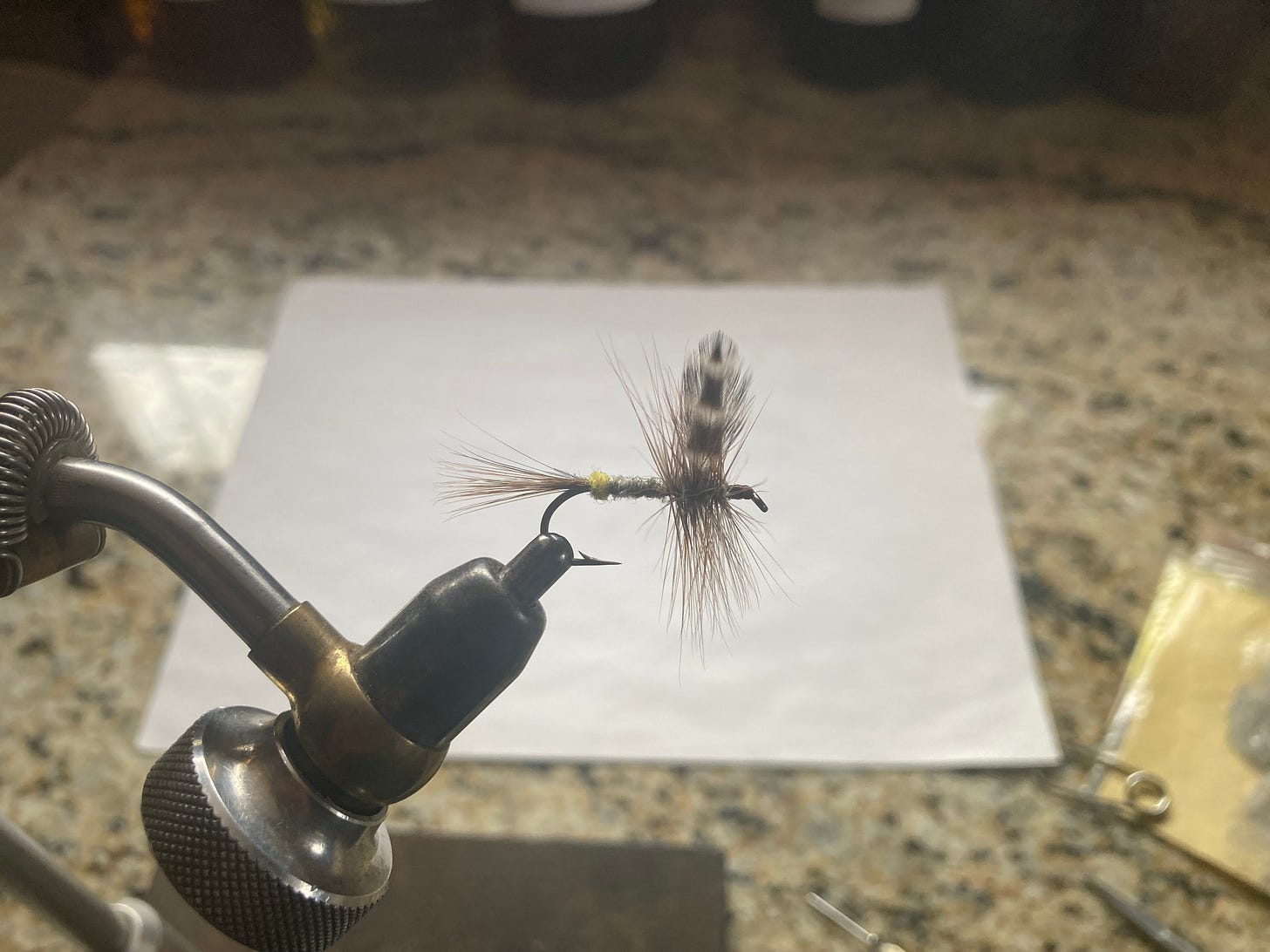January 6th, 2024 Issue
Developing A Watering Strategy / Fermented Plant Juice (FPJ) Part 1 / Dandelion- Taraxacum officinale / Float Fishing Lesson #14 Dragonfly / Fly Tying Lesson #14- Female Adams Dry Fly
Developing A Watering Strategy
You have heard me mention in the past, that no two gardens will be the same, for a multitude of reasons. Climate, soil type, personal preferences just to name a few. So whenever I share my thoughts on watering, it is important to realize, that my practices are not necessarily something you can copy exactly. If someone with a clay soil were to try to do exactly what I do on sand, it would be disastrous. I have learned to love my sandy soil, because it is so very forgiving in extreme situations, like flooding. As long as my ground water in the well holds out, in droughty years I have had some of my best gardens. The dry air is difficult for pests and diseases to flourish in.
But I definitely want to share with you, not only what I have chosen to do, but the why behind it. It is always important that we understand the “why” in what we do. If you don’t, it will be difficult for you to learn how to nuance or completely change it. The word tradition, has never even entered my vocabulary, in regards to gardening. Because from day one, I have been on a continuing quest, to learn how to do thing just that much better, with each progressing season.
First of all, let me remind you of the most important reason to water. That is to keep the soil profile adequately moist enough to support the activity of your soil livestock. It just so happens if the soil is adequately moist enough for them, it will probably be for the plants as well. The biology is our primary focus though.
How often I will need to water, will be dependent on several things. If the soil is mulched, how hot and dry it has been, and the preference of the particular plant. Having a mulch over the soil can usually be very advantageous, but it will depend on what we are trying to achieve. If you go back to the articles that talk about mulches, you will see that they can vary greatly. A rock mulch for sweet potatoes that is causing the soil too warm to ninety degrees, is going to dry out faster than a wood chip mulch, that will tend to keep the soil cooler.
Last summer we were droughty, but the temperature was also more mild. Nothing like some years that have the lack of rain, and an excessive heat index. In those conditions I will probably offer my plants shade cloth and water at midday to give them some relief.
One thing you will definitely need to learn, is what each type of plant prefers. I will water my Brassicas (Cabbage, Kale, Cauliflower, and Broccoli), Carrots, Parsnips, Onions, Shallots, Garlic, Parsley, Lettuce, Beets, Spinach, and other greens, every evening unless it rains. If you have clay soil, you would need to be very careful with that advice. These plants, and their particular microbiomes thrive being damp, in my area. Maybe you will find a particular foliage disease in your area, that I don’t have here, that would prevent you from doing the same. One summer when it was very hot, we soaked our beets for the restaurant two times each day, and had the biggest harvest ever. Generally root crops need ample water for them to swell to larger proportions.
Now with plants that struggle with foliage disease. I will tend to water them once a week more heavily, but in the late morning to early afternoon. I want the sun to have a chance to dry the plants foliage, if at all possible.
With discerning their needs, a moisture meter, with a long probe will prove very valuable. It will save you watering more than you need to. But at other times, you will find that you need to give four times as much water as usual. I have a week or so each season, that my potatoes need four inches of water because they are swelling so rapidly. The only way you will figure the timing of this application of water, will be to monitor it. Sweet corn is very similar when it is starting to pollinate.
I want to take a moment, and teach you the math that I use to figure out how much water I am applying. It is this same math, that I use to figure out how much compost and Ramial as well. The number you need to memorize is 231. It is easy for me, because that is our area code. There are 231 cubic inches per gallon. Now if I want to apply an inch of something over my garden beds, I need to figure out how many cubic inches exist on the surface of the bed. To make math a little easier, let’s say that our garden bed is 4’x25’, so 100 square feet. In each square foot (12”x12”) there are 144 cubic inches. So if we times that by the 100 square feet, we know that we will need 14,400 cubic inches of material.
Now if I am figuring compost or Ramial poured out of 4 gallon buckets. Then each 4 gallon bucket will have: 231 cubic inches per gallon X 4= 924 Cubic inches per 4 gallon bucket. If I wanted to apply a full inch deep, then I would divide the 14,400 cubic inches total over the whole bed, by the 924 cubic inches per 4 gallon bucket. That means I would need to pour 15.58 4 gallon buckets. If I only needed a 1/4” deep of material, then I would divide the 15.58 by 4 and apply 3.89 or probably 4 buckets.
Now with hand watering with a fan sprayer like I am using, you have to take your math one step further. Get a bucket, attached a hose to the hydrant you intend to water from, the sprayer you will use, and a timer. Now time how long it takes to fill a four gallon bucket. For easy math, let’s say it took 60 seconds, one minute. If you already know from your previous math that you need 15.58 buckets for an inch of material, then if it takes a minute to apply each bucket then you will need to water for 15.58 minutes. Or let’s just say 16 minutes. If you desire less than an inch just divide accordingly. If you need 4” of water then it will take, 64 minutes.
Now I mentioned I was using a fan sprayer. You can see in the next photograph how I modify mine. They come with much smaller holes. I take a 1/16” drill bit, and drill each of them out. This allows me much more volume over a shorter distance. All I need to do, is reach across a six foot wide bed, which this does well with the average water pressure I have available.
Some of you are thinking, that you are amazed I take the time to hand water. Over the years I have tried most everything. Soaker hoses, drip tapes, sprinklers of every type, and nothing even comes close to what I can achieve hand watering. I am not alone in this. Charles Dowding and John Jeavens who have both been doing this twice as long as I have, have come to the same conclusion. Most peoples gardens are so big, and the plants so spread out that it would seem impossible. Once you learn how to grow intensively and bring the foliage of your plants closer together to help shade the soil. You will not need nearly as much water as you do now.
When I water my beds, it is like spray painting. I will water until the surface becomes glossy, and then I will move off before it runs. If the water soaks in immediately, then I know the soil has good moisture. If it stays on the surface, them I know that there is a hydrophobic layer that is not allowing the water to penetrate, therefore I know it is dry. I will be careful to keep watering until I can see I get good penetration. I could also check the profile with the moisture meter. This can be important. I have seen times there will be a dry band of soil at a certain depth that a moisture meter can reveal to you very quickly. I am also carful to water the edges of the beds a little extra, because that is where it will tend to dry out first.
The problem with soaker hoses and drip tape, is their application of water is much too limited. Most people do not realize how aggressive, and far reaching most healthy plant’s roots will grow. It is very common for my tomato plants, once they have reached eight foot tall, to have roots going out six feet in all directions. On several occasions I have had commercial tomato growers come to me with questions about blossom end rot on their tomatoes. The first thing I will ask them is if they are using drip tape. Every time I can remember they have said yes. Blossom end rot is caused by a calcium deficiency. You can have plenty of calcium in your soil, and if the roots come into contact with dry soil, they cannot uptake it properly. This is a very common cause.
I would probably choose sprinklers over the drip tapes and such, but even here they have many problems. We get quite breezy from time to time. Sprinklers already struggle with putting out a completely even spread of water, but add some wind and you might as well give up. Even when it isn’t too windy, some areas are more damp and others still dry. For my Quilt Garden, sprinklers would be impossible. Each Quilt square is receiving different kinds of care. In fact I will purposely put a plant that does not like its foliage wet next to a plant that does and is watered more often. The roots of the sensitive plant can come and enjoy some of the excess when it is needed. To put a sprinkler on everything at once, would cause a lot of problems with certain plants, because all the different plants foliage will get soaked.
Probably the biggest reason I like to hand water, is because it allows me to look over the plants very carefully, as I work my way through them. My eyes are even going over the plants, that may not be receiving water. I am able to notice possible problems early on by inspecting them everyday. How convenient to turn on some form of irrigation, or a timer and then walk away. But I find the more I am with the plants, and they receive my attention, the more they thrive.
Like I said at the beginning, everyone’s strategy will be a little different. Hopefully some of these thoughts, will help you to develop yours. God bless your efforts!
The Regenerative Homestead Newsletter’s Main Index
This link will take you to a full Index, of all the articles that I have published, organized by topic. Making it very easy for you to go back, and revisit an article that you wanted to review again in the future.
I published this article in a separate newsletter last Tuesday. This link will take you to that newsletter.
If you know someone, that you think would enjoy this newsletter, please let them know by sharing it. Thank you!
Fermented Plant Juice (FPJ) Part 1
I am choosing FPJ as our first solution to teach you, because it will help illustrate some important points. One of the things that was stressed, in our KNF class, that Chris Trump taught. Was the need to learn how to do the solutions and use them just like we were being instructed. This is one of the ways that the western and eastern minds are very different. In Korea, as you are learning how to do something, you realize that you will need to do just as your instructor teaches you. You would want to master the techniques that you were shown, before you would ever consider changing something or trying to improve it. How can you improve something, until you have experienced its full benefits? Or observed its nuances? This is very different than the western mind, especially in men.
I know on a personal level and as a teacher. When I was in my twenties, I was a fly casting instructor for Orvis. I had taught so many classes, that in time I was able to predict who by the end of the class would actually improve their casting. The vast majority of the casters that would improve would be woman. Most men, but not all, will generally listen to what you say and extract from it the 10% they think they need, and add it to the 90% they think they have already figured out. Most of the time making very few improvements because of past bad habits they don’t understand yet. It really got to the point of being laughable. Just like not all men fell into this generalization. Not all woman, but most, would listen to what I was saying, simply try it, and much more readily received constructive criticisms and benefit from them. In other words, the vast majority of the woman in the class were much better casters by the end of the class. I think the Lord had me experience this for a reason, I tend to be someone that loves innovating what I do. But it is truly difficult to innovate, in a profitable way, until you have started to learn to master your trade.
FPJ illustrates this point really well. Once you learn and utilize it properly, you will be astonished at the amount of misinformation that is out there. Even being published by well know publishers, by authors that have never received any formal instruction in these techniques. Most of the information you will find about FPJ in YouTube videos could actually work to harm your plants. The teachers are not aware that they are leading people astray. They are probably just parroting what they heard on a video that misinformed them.
FPJ, is the process of extracting, through fermentation, the plants juices and unique microbiomes. If done properly, the plants growth hormones, chlorophyl, minerals, and a host of other plant compounds can be transfer to another plant through foliar application. Foliar feeding, or feeding a plant by lightly spraying its leaves with a fine mist, can be very effective if done properly. The leaf of a plant can uptake minerals and other substances, two hundred times faster than through their roots. For this reason the fertilizer value can be quite effective. Allowing you to use much less than you would think necessary. Along with transferring the plants other properties, you can also establish unique biology from one plant to another. We will have very specific rules we will follow to make this transition the most effective it can be.
For instance, when you collect your plant material that you will use, you will wait at least three days after a rain. Rain tends to wash off some of the colonized microbes from the leaves of the plants. By waiting at least three days, you are allowing the microbes to replenish themselves on the leaves. You will make your collection just before the sun rises in the morning, while the plant has a good heavy dew on its leaves. This dew has allowed the biology to multiply overnight and will be at their peak just before the sun comes up. The way plants transfer their energy, from root to leaf back and forth through the twenty four hour period, makes sunrise an ideal time as well to capture the most benefit. So if you are the type of person that is just going to say “I don’t see what the big deal is all about having to get out of bed so early”, and your going to wander out at ten o’clock in the morning while the leaves are dry , and the leaves are already changing their chemical composition, then don’t expect the same results as someone that follows the instructions very carefully.
The founder of KNF, Master Cho, as they call him, has spent 50 years developing this system. He has painstakingly sought to learn important nuances, and to pass them on to others, that will in tern pass them on the same way. That being said, you will find that even different teachers that have learned directly from Master Cho do teach some thing a little different. I have chosen to try to pass to you just what Chris taught us, because he has used it to very successfully, convert a conventional Macadamia nut farm, that was doing very poorly in Hawaii, to being fully organic certified and thriving using all KNF techniques. The USDA experts told him it couldn’t be done. It has been done on a large scale of hundreds of acres. Taking the instruction from someone that has been very successful with it means something to me.
In my next newsletter I will go through just how to make an FPJ. One of the biggest mistakes that people make with using FPJ, is spraying it by itself. Chris likened it to giving the plant a backpack of candy. It needs to be sprayed within what they call maintenance solution. That is a mixture of FPJ, brown rice vinegar BRV, and oriental herbal nutrient OHN (tinctures made specifically for plants). If it is sprayed without the BRV and OHN then you are inviting pest and disease problems. Used properly together, it will combat them admirably. Especially in those wet summers when foliar disease can so easily get out of hand. I look forward to teaching you how to properly use these very beneficial techniques.
Dandelion- Taraxacum officinale
Dandelions are one of those plants that most everyone is familiar with. This plant is a powerhouse of nutrition. All the parts of this plant are edible. The older leaves tend to be more bitter, than the young growth. It is good for you to have some bitters in your diet though. I will generally put a few older leaves in my summer salads and cannot tell the difference.
The roasted root makes an amazing coffee substitute, that is way better for you. The root is also used to make tinctures and tea. I will often put the flowers raw in my salads as well. Being careful to leave some flowers for the bees, because they are such an important early pollen source.
The roots of the plants go deep into the subsoil. Bringing up nutrients that have leached out of the reach of most other plants. This is really important, because once the plant dies, those minerals are made available to shallower rooted plants. I will take as many as I can get in my pastures, and will often allow them to grow large in my mineral rich garden soil, so that the plants I harvest for my personal use, are of the highest quality.
Float Fishing Lesson #14 Dragonfly
Ever since I was a young child I have really enjoyed watching Dragonflies hunt. They are amazing. There is a pond across the road from my garden. It isn’t uncommon to have dragonflies hunting in my garden at certain times during the season. They do a great job with mosquito control.
The life cycle of a dragonfly is quite simple. The adult lays its eggs and the nymphs will develop. When the nymphs are full grown, they will crawl out of the water on a stick or rock that is exposed and emerge from their nymphal shuck. After they emerge they are a formidable predator in aquatic environments.
I have had great days fly fishing for trout, with imitations fished shallow. They have a very distinctive swimming style, of jetting water through their abdomen in pulses of three. So I would cast very close to the bank and retrieve my line with three short strips and then a pause, then three more short consecutive strips again. The fish take them fairly aggressively.
If you are float fishing, they will be most prominent in lakes or slower canals. If you were able to collect the actual nymphs, they could be fished from an appropriate size hook as live bait. I have not personally fished them live, but would think it would be deadly. Giving it some action would probably work best. Remembering the nymphs are migrating to the shallow water to hatch. Bank fishing very carefully and retrieving it to the bank would be best. I say carefully, because the large fish that are seeking them out, can be very close to the bank.
Fly Tying Lesson #14- Female Adams Dry Fly
In this lesson I will show you how to tie a Female Adams dry fly, with a yellow egg sack.
https://rumble.com/vwm5gl-fly-tying-class-lesson-14-female-adams-dry-fly.html


















The FPJ you spoke of sounds very interesting The Lord willing, I'd like to give it a try in my garden this year. Does it work well with pernnials, asparagus and stawberries, too? May God Bless you as you go through week 2 of the new year.